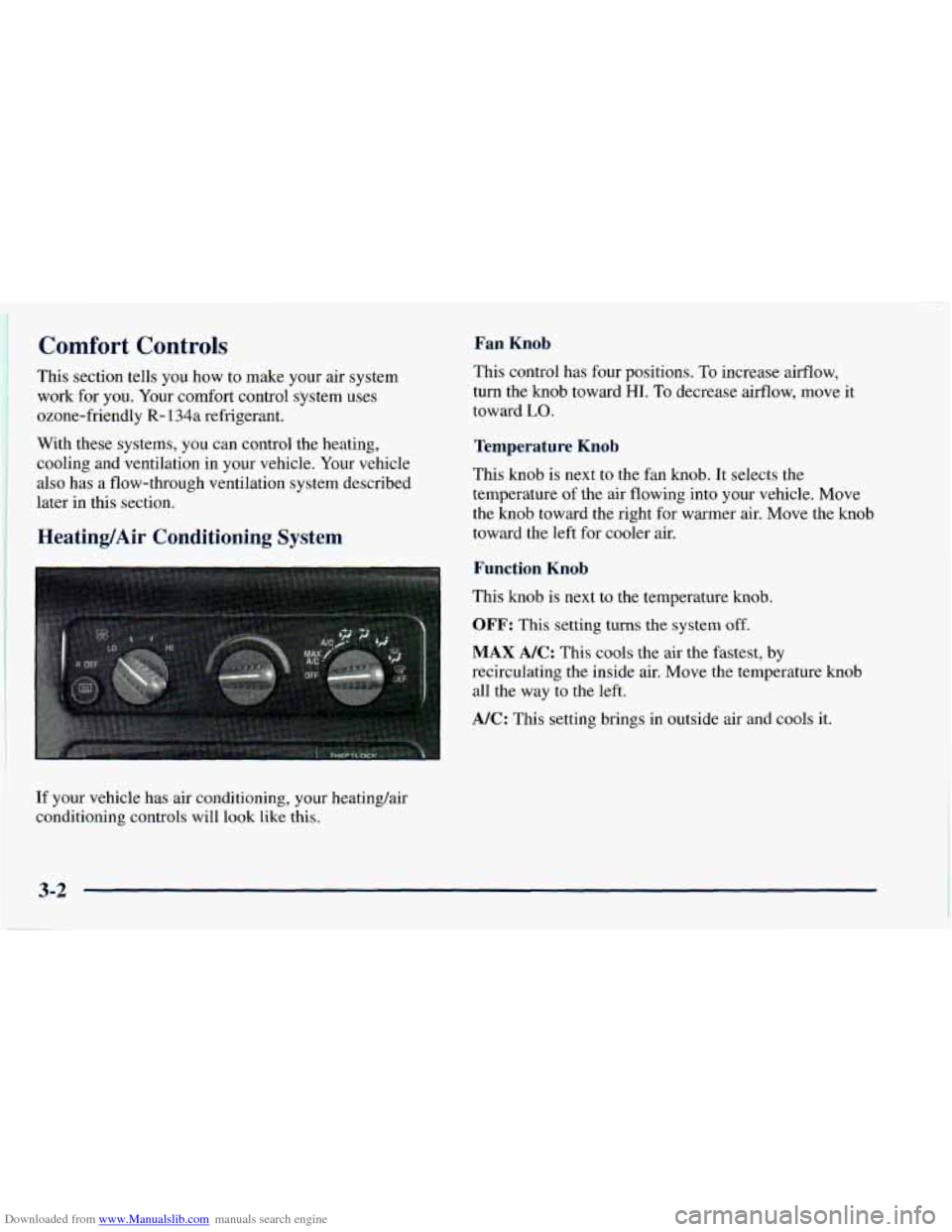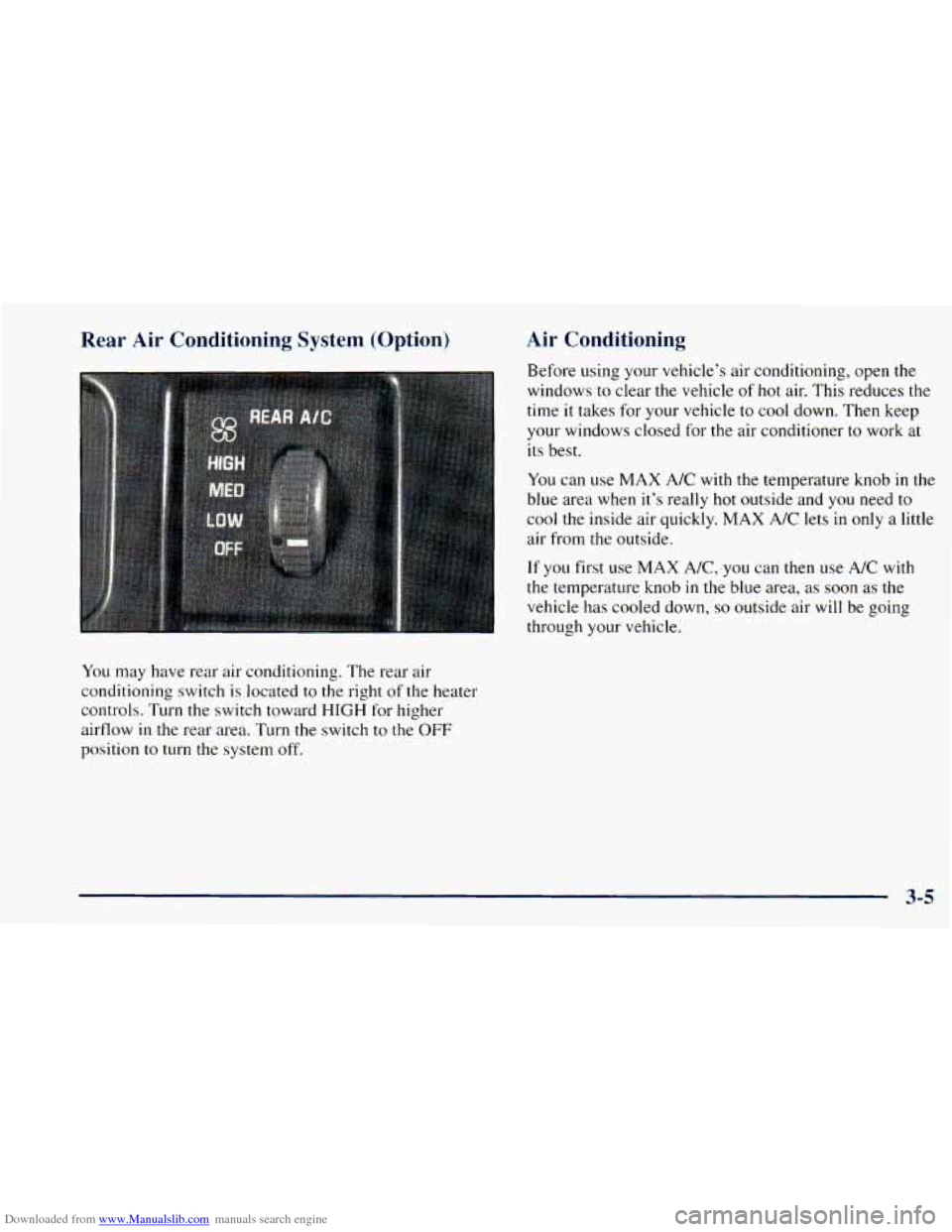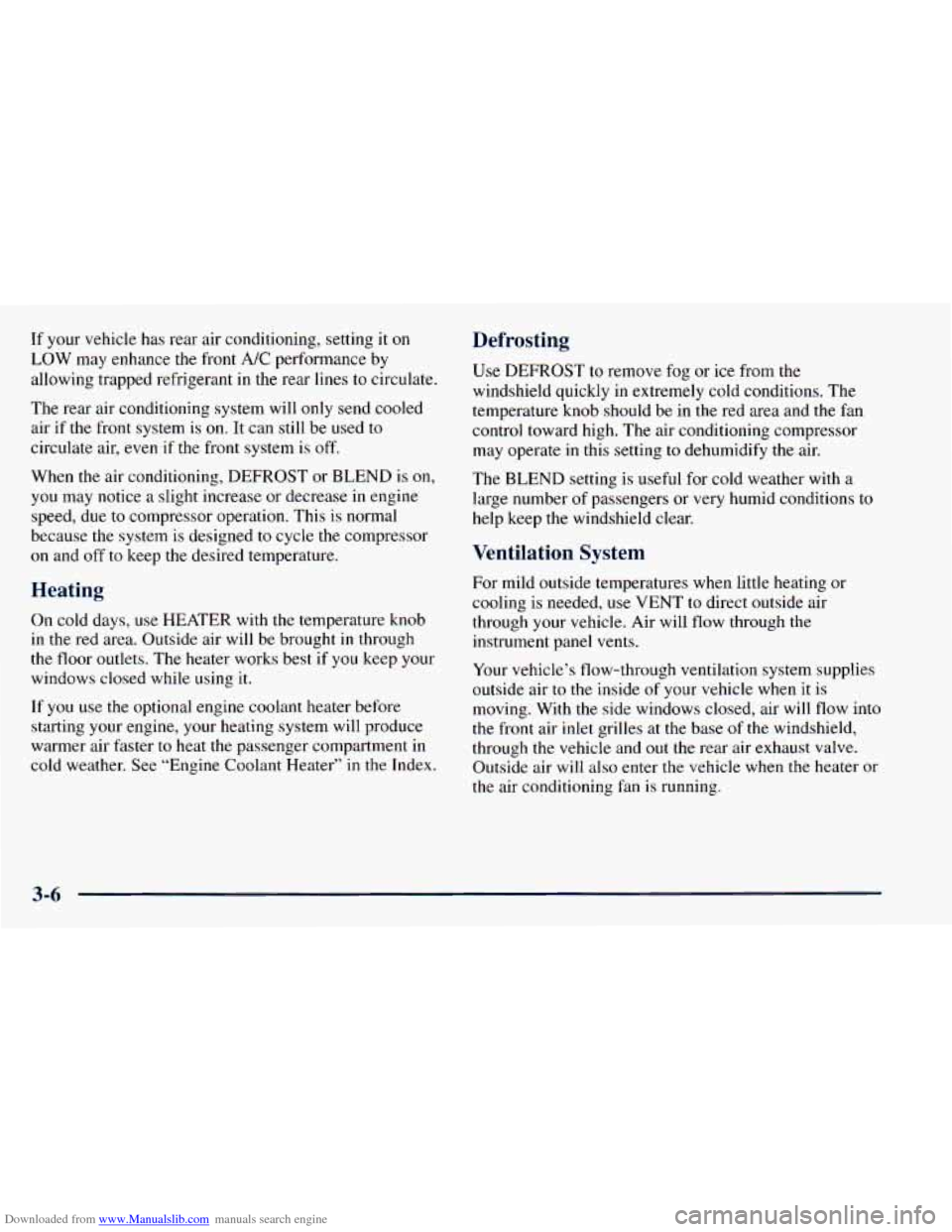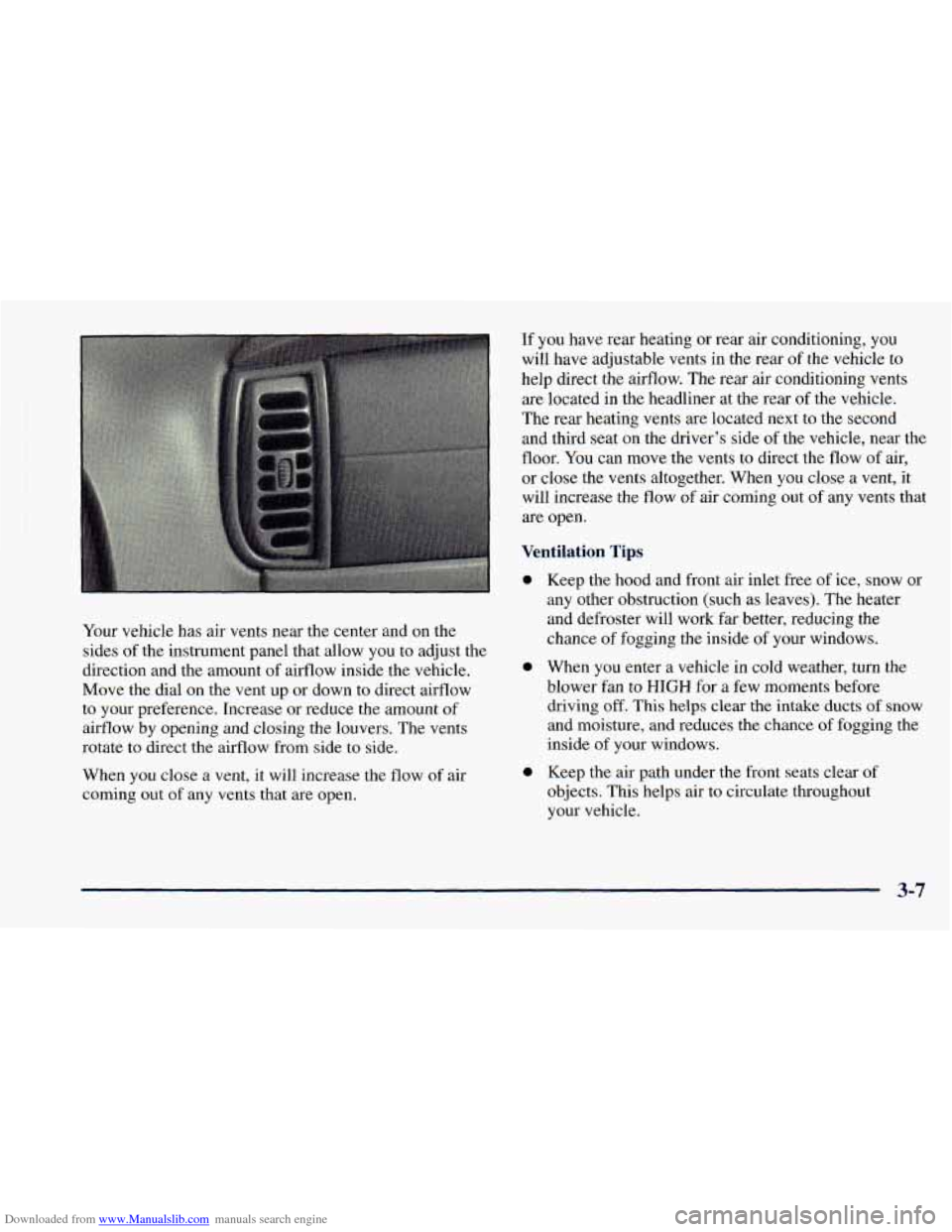1998 CHEVROLET ASTRO air conditioning
[x] Cancel search: air conditioningPage 153 of 414

Downloaded from www.Manualslib.com manuals search engine Section 3 Comfort Controls and Audio Systems
In this section, you’ll find out how to operate the comfort control and audio systems offered with your vehicle. Be
sure
to read about the particular systems supplied with your vehicle.
3-2
3-2 3-3
3 -4
3-5 3-5
3-6
3
-6
3-6
3-8
3-9
3-9
3 -9
3-9 Comfort Controls
Heating/Air Conditioning System
Heating System
Rear Heating System (Option)
Rear Air Conditioning System (Option)
Air Conditioning
Heating
Defrosting
Ventilation System
Rear Window Defogger (Option)
Audio Systems
Setting the Clock for Systems without
Automatic Tone Control
Setting the Clock for Systems with
Automatic Tone Control
4M-FM Stereo 3-1
1
3-13
3-18
3- 19
3-24
3-26 3-28
3-28 3-29
3-30
3-30
3-30 AM-FM
Stereo with Cassette Tape Player
(If Equipped)
AM-FM Stereo with Cassette Tape and
Automatic Tone Control (If Equipped)
Rear Seat Audio
(If Equipped)
AM-FM Stereo with Compact Disc Player
and Automatic Tone Control (If Equipped)
Remote Compact Disc Player (If Equipped)
Theft-Deterrent Feature (If Equipped)
Understanding Radio Reception
Tips About Your Audio System
Care of Your Cassette Tape Player
Care
of Your Compact Discs
Care of Your Compact Disc Player
Fixed Mast Antenna
3-1
Page 154 of 414

Downloaded from www.Manualslib.com manuals search engine Comfort Controls
This section tells you how to make your air system
work for you. Your comfort control system uses
ozone-friendly
R- 134a refrigerant.
With these systems, you can control the heating,
cooling and ventilation in your vehicle. Your vehicle
also has a flow-through ventilation system described
later in this section.
Heating/Air Conditioning System
If your vehicle has air conditioning, your heating/air
conditioning controls will look like this.
Fan Knob
This control has four positions. To increase airflow,
turn the knob toward
HI. To decrease airflow, move it
toward
LO.
Temperature Knob
This knob is next to the fan knob. It selects the
temperature of the air flowing into your vehicle. Move
the knob toward the right for warmer air. Move the knob
toward the left for cooler air.
Function Knob
This knob is next to the temperature knob.
OFF: This setting turns the system off.
MAX NC: This cools the air the fastest, by
recirculating the inside air. Move the temperature knob
all the way to the left.
A/C: This setting brings in outside air and cools it.
3-2
Page 155 of 414

Downloaded from www.Manualslib.com manuals search engine -bo
+@ BI-LEVEL: This setting brings in outside air
and blows
it out through the heater floor vents and the
instrument panel
vents. If you move the temperature
knob between hot and cold, cooler air will come
out of
the upper vents while warmer air comes out of the floor
vent. The air conditioning compressor may operate in
this setting to cool the air.
/J VENT The air comes out at the vents on your
instrument panel. The air conditioning compressor will
not run in this position. Adjust the temperature knob for
warmer or cooler air.
+' HEATER: Most of the air comes out near the
floor. The rest comes
out from the defroster vents under
the windshield and at the front side windows.
+, BLEND: With this setting, the heated outside air
comes out both the heater vents and defroster vents.
Adjust the temperature knob for warmer or cooler air.
The air conditioning compressor may operate in this
setting
to dehumidify the air.
rl*.
0
w.
DEFROST This setting operates the defroster.
Most
of the air comes out near the windshield, with
some going
to the floor vents and front side windows.
The air conditioning compressor may operate in this
setting to dehumidify the air.
Heating System
If your vehicle does not have air conditioning, your
heater controls will look like this.
Fan Knob
This control has four positions. To increase airflow,
turn
the knob toward HI. To decrease airflow, move it
toward
LO.
Temperature Knob
This knob is next to the fan knob. It selects the
temperature of the air flowing into your vehicle. Move
the knob toward the right for warmer air. Move
the knob
toward
the left for cooler air.
3-3
Page 157 of 414

Downloaded from www.Manualslib.com manuals search engine Rear Air Conditioning System (Option) Air Conditioning
Before using
your vehicle’s air conditioning, open the
windows to clear the vehicle
of hot air. This reduces the
time
it takes for your vehicle to cool down. Then keep
your windows closed for the air conditioner to work at
its best.
You can use
MAX A/C with the temperature knob in the
blue area when it’s really
hot outside and you need to
cool the inside air quickly.
MAX A/C lets in only a little
air from the outside.
If you first
use MAX A/C, you can then use A/C with
the temperature knob
in the blue area, as soon as the
vehicle has cooled down,
so outside air will be going
through your vehicle.
You may have rear air conditioning. The rear air
conditioning switch is located
to the right of the heater
controls. Turn the switch toward
HIGH for higher
airflow in the rear area. Turn the switch to the
OFF
position to turn the system off.
3-5
Page 158 of 414

Downloaded from www.Manualslib.com manuals search engine If your vehicle has rear air conditioning, setting it on
LOW may enhance the front
A/C performance by
allowing trapped refrigerant in
the rear lines to circulate.
The rear air conditioning system will
only send cooled
air if the front system is
on. It can still be used to
circulate air,
even if the front system is off.
When the air conditioning, DEFROST or BLEND is on,
you may notice a slight increase or decrease in engine
speed, due to compressor operation. This is normal
because the system is designed
to cycle the compressor
on and off to keep the desired temperature.
Heating
On cold days, use HEATER with the temperature knob
in the red area. Outside air will be brought in through
the floor outlets. The heater works best if you keep your
windows closed while using it.
If you use the optional engine coolant heater before
starting your engine, your heating system
will produce
warmer air faster
to heat the passenger compartment in
cold weather. See “Engine Coolant Heater” in the Index.
Defrosting
Use DEFROST to remove fog or ice from the
windshield quickly in extremely cold conditions. The
temperature knob should be in the red area and the fan
control toward high. The air conditioning compressor
may operate
in this setting to dehumidify the air.
The BLEND setting is useful for cold weather with
a
large number of passengers or very humid conditions to
help keep the windshield clear.
Ventilation System
For mild outside temperatures when little heating or
cooling is needed, use VENT
to direct outside air
through your vehicle. Air will flow through the
instrument panel vents.
Your vehicle’s flow-through ventilation system supplies
outside air to the inside of your vehicle when it is
moving. With the side windows closed, air will flow into
the front air inlet grilles at the base of the windshield,
through the vehicle and
out the rear air exhaust valve.
Outside air will also
enter the vehicle when the heater or
the air conditioning fan is running.
3-6
Page 159 of 414

Downloaded from www.Manualslib.com manuals search engine Your vehicle has air vents near the center and on the
sides of the instrument panel that allow you to adjust the
direction and the amount of airflow inside the vehicle.
Move the dial on the vent up or down to direct airflow
to your preference. Increase or reduce the amount of
airflow by opening and closing the louvers. The vents
rotate to direct the airflow from side to side.
When you close a vent, it will increase the flow of air
coming out of any vents that are open. If you
have rear heating or rear air conditioning, you
will have adjustable vents in the rear of the vehicle to
help direct the airflow. The rear air conditioning vents are located in the headliner at the rear
of the vehicle.
The rear heating vents are located next to the second
and third seat
on the driver’s side of the vehicle, near the
floor.
You can move the vents to direct the flow of air,
or close the vents altogether. When you close a vent, it
will increase the flow of air coming out of any vents that
are open.
Ventilation Tips
e
e
a
Keep the hood and front air inlet free of ice, snow or
any other obstruction (such as leaves). The heater
and defroster will work
far better, reducing the
chance
of fogging the inside of your windows.
When you enter a vehicle in cold weather, turn the
blower fan to HIGH for
a few moments before
driving off.
This helps clear the intake ducts of snow
and moisture, and reduces the chance of fogging the
inside of your windows.
Keep the air path under the front seats clear of
objects. This helps air to circulate throughout
your vehicle.
3-7
Page 263 of 414

Downloaded from www.Manualslib.com manuals search engine Section 6 Service and Appearance Care
Here you will find information about the care of your vehicle. This section begins with service and fuel information,
and then it shows how to check important fluid and lubricant levels. There is also technical infc lation about your
6-2
6- 3
6-
5
6-7
6-7
6- 10
6- 15
6- 19
6-20
6-23
6-25
6-25
6-28
6-29 6-29
6-30
6-3
1
6-35 vehicle,
and a part devoted to its appearance care.
Service
Fuel
Filling Your Tank
Filling a Portable Fuel Container
Checking Things Under the Hood
Engine Oil Engine Cover
Air Cleaner
Automatic Transmission Fluid
All-Wheel Drive
Rear Axle
Engine Coolant
Radiator Pressure Cap
Thermostat
Power Steering Fluid
Windshield Washer Fluid
Brakes
Battery 6-36
6-36
6-42
6-42
6-5 1
6-5
1
6-53
6-55
6-56
6-57
6-57
6-58
6-59
6-59 6-60
6-67
6-68
6-69 Bulb
Replacement
Halogen Bulbs
Windshield Wiper Blade Replacement
Tires
Appearance Care
Cleaning the Inside of Your Vehicle
Cleaning the Built-in Child Restraint
Cleaning the Outside
of Your Vehicle
Cleaning Tires
Finish Damage
Underbody Maintenance
Appearance Care Materials Chart
Vehicle Identification Number (VIN)
Service Parts Identification Label
Electrical System
Capacities and Specifications
Air Conditioning Refrigerants
Normal Maintenance Replacement Parts
6-1
Page 330 of 414

Downloaded from www.Manualslib.com manuals search engine Rear Axle Capacity
Standard Rear Axle . . . . . . . . . . . . . . 3.5 pint (1.7 L)
Locking Rear Axle . . . . . . . . . . . 3.5 pint (1.7 L)
Air Conditioning Refrigerants
Not all air conditioning refrigerants are the same.
If the air conditioning system in your vehicle needs
refrigerant, be sure the proper refrigerant is used. If
you’re not sure, ask your dealer.
Refrigerant should be added only by a qualified
NC technician.
Air Conditioning Refrigerant Capacity
mPe
R- 134a
R- 134a
System
C-60**
C-69***
*All quantities are approximate.
**Front
A/C only.
***Front and Rear A/C.
Quantity*
2 lbs. (0.91 kg)
3 lbs,
(1.36 kg)
NOTICE:
R-134a refrigerant is not compatible with R-12
refrigerant in an air conditioning system. R-12 in
an R-134a system
will cause compressor failure,
refrigerant oil sludge
or poor air conditioning
system performance.
6-68